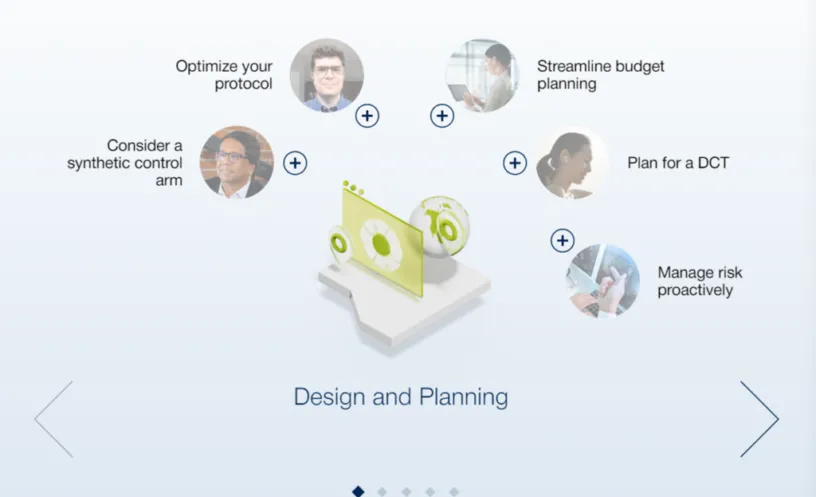A Comprehensive Technology Roadmap for a Successful Clinical Trial

Every step of a clinical trial must be executed effectively and efficiently to maximize the chances of its success. Medidata is introducing “Your Technology Roadmap Through the Clinical Trial Process”, a new, interactive tool to guide early-stage, small, and mid-sized pharma and biotech companies through discovering and assessing their optimal technology path.
Read on to learn more about each step in the trial process and specific clinical trial technologies that help achieve better study outcomes.
Step 1: Design and Planning
The planning of your clinical trial determines its success. Key clinical trial technologies can help optimize your protocol as the study details are defined, and identify sites that are likely to achieve recruitment and diversity goals.
To enhance patient experience and increase levels of engagement, flexibility and reduction of patient burden are key factors that can be achieved using a decentralized clinical trial (DCT). But small patient populations pose a challenge when conducting studies of rare diseases. A synthetic control arm (SCA) approach can help sponsors limit this issue using historical data.
The clinical trial technology roadmap tool explores solutions that support remote participation of patients and staff while adhering to regulatory requirements via DCTs; it also explains the technology for an SCA and its use to promote recruitment and retention of patients.
Being proactive is pivotal to ensure patient safety throughout the trial process and avoid costly delays. The technology roadmap shares a holistic approach called risk-based quality management (RBQM), a strategy to ensure data integrity, patient safety, and overall trial quality.
In the wrap-up of the design and planning step, the technology roadmap outlines technology solutions that ensure budget accuracy and transparency across the entire budget and investigator grant lifecycle.
Step 2: Startup
Getting your trial up and running efficiently is particularly time consuming. The technology roadmap identifies functional areas where technology can help streamline study startup.
Site selection and feasibility tools let sponsors quickly identify potential sites based on specific criteria such as patient population, location, and previous trial experience. Once sites are selected, a clinical trial management system (CTMS) helps monitor sites for fast issue identification and remediation. A CTMS solution integrated with an electronic data capture (EDC) solution on a cloud-based platform offers several advantages over a traditional, disparate on-premise system, including process automation to reduce error-prone manual processes and provide real-time visibility into trial progress.
By using a CTMS solution and an electronic trial master file (eTMF), sponsors can keep track of essential documents, manage data centrally, and gain better insights into study performance.
Steps 3 & 4: Conduct: Clinical Data Acquisition, Management, and Monitoring
Intensive resources are used to capture patient data, collect study data, and monitor progress throughout a clinical trial. The technology roadmap highlights approaches to simplify the process, integrated with extended clinical trial capabilities to improve data quality.
An EDC solution eliminates the need for paper records. EDCs digitize the clinical trial process, reduce data entry errors, improve data quality, and safeguard the privacy and security of patient data.
This stage includes the essential selection of a randomization and trial supply management (RTSM) solution to also manage dispensing the investigational product (IP). An RTSM solution integrated with an EDC solution on a cloud-based platform offers enhanced security, scalability, and flexibility—plus real-time visibility into trial progress, which lets sponsors identify and address issues quickly.
Study sponsors have ethical and practical responsibilities to monitor and manage data throughout a clinical trial to make sure it adheres to regulatory requirements and produces reliable and valid results. The clinical trial technology roadmap dives into effective oversight solutions that protect trial patients' rights and safety and maintain the trial data's integrity.
Step 5: Closeout
Your closeout process requires study results that are accurate, validated, and usable. The technology roadmap highlights solutions that streamline the process of collecting, managing, and analyzing end-of-study data. Sponsors can manage the entire closeout process electronically, from patient data collection to database lock.
During the closeout step, end-of-study data is also prepared for adjudication to deliver accurate and complete clinical endpoint data to make informed decisions about the safety and efficacy of new treatments.
Leverage clinical trial technology that simplifies the entire adjudication process—from data collection to submission—enabling faster and more accurate data processing. Solutions that support investigator sites, sponsors, CROs, data managers, and the clinical event committee (CEC) in collecting, managing, organizing, adjudicating, and submitting clinical endpoint data lead to faster closeout of clinical trials.
Discover What Truly Matters to Your Clinical Trial Process
The clinical trial technology roadmap interactive tool provides a comprehensive technology perspective throughout the clinical trial process, spotlighting an innovative solution at each step. As you journey through the clinical process via the technology roadmap, you’ll discover critical topics that can be addressed with technology. This lets you focus on what’s most important: ensuring the safety and well-being of your trial patients while driving medical innovation forward.
Contact Us
